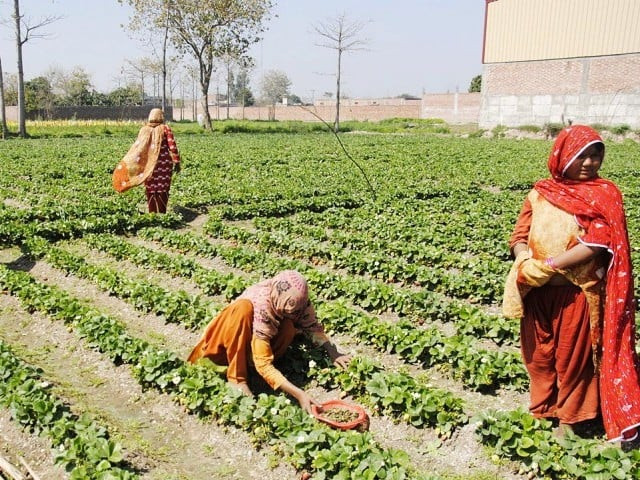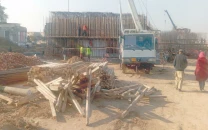The nightmare of sexual violence for female farmworkers
Seventy-eight per cent women workers in agriculture have limited means to communicate concerns

In Pakistan, the Harassment Act 2010 does provide space for agriculture workers to find relief in case of harassment at workplace. PHOTO: EXPRESS
Bheel’s is just one of the cases depicting the hazards women working in agricultural fields face. The 73% of women workers (out of Pakistan’s 26% female labour force) attached to the agriculture sector have limited means of communicating their concerns, whether they’re related to their employment conditions, position as unpaid family workers or health risks due to increased use of pesticides. Most importantly, the sense of insecurity experienced while working under a power relationship where the employer, supervisor or even their acquaintance is in a position to threaten, exploit, chain, or expel with impunity is hardly documented or addressed.
Christian woman claims she was sexually harrassed to avenge Muslims girl’s elopement
 Guddi Bheel
Guddi BheelIt is difficult to imagine an act of harassment leading to a brutal murder taking place at a tech firm, a bank, a media house, an English medium school, a private hospital or a higher education institute in Pakistan. The formal sector workplaces offer better protections against harassment, both in terms of physical structures as well as by way of the application of the Protection Against Harassment of Women at The Workplace Act 2010 legislation. The comprehensive legislation seeks to act as an effective deterrent against harassment and offers remedies too.
Woman among three shot, tortured in child molestation case
On the other hand, the picture in agriculture is markedly different. Labour attached to the agriculture sector is disadvantaged in a wide variety of ways. First of all, no labour laws – those related to the freedom of association, child labour, forced labour, non-discrimination, minimum wage or conditions of work – is applicable to the sector. This is most ironical because the sector absorbs 45% of the country’s workforce. The informality of the employment arrangement as well as working conditions further reinforce marginalisation and disadvantage for the workers. The open spaces where work and shelter merge leave workers’ families exposed to exploitation ranging from extra unpaid work to harassment of women to threats of bondage restricting their movement through coercive means. Access to basic amenities such as electricity, toilets and healthcare facilities is off the table. Protection in the form of outreach to a police station or DC office is even out of the question. Both state services and mobility remain extremely crippled for Pakistan’s rural areas, which is where much of agriculture is based.
Both nationally and globally, sexual harassment in agriculture fields is much widespread than documented. Firstly, the sector is increasingly being dominated by females. In Food and agriculture Organisation (FAO) reports, South Asia and Sub Saharan Africa have been identified as two regions with a huge majority of working women employed by the agriculture sector. The share is 70% and 50%, respectively. In on-farm agriculture, women work under male supervisors. The workplace is an open field, occupying hundreds of acres, isolating workers from each other and providing opportunity for predators to launch an attack without the threat of being noticed. Tied in an informal work arrangement with no legal contracts, in addition to extreme poverty, women find themselves unable to register a complaint with the employer or landlord. Even in countries where stronger mechanisms against sexual harassment are available to agriculture workers, filing a complaint is not a choice. Job insecurity is described as a major reason behind this reluctance. In 2014, the Centre for Investigative Reporting and the Investigative Reporting Program at the University of California-Berkeley reviewed extensive records and visited fields across the United States to document stories of sexual assault of agriculture workers. They noted: “Although agriculture is America’s oldest industry, the first sexual harassment lawsuit against a grower to reach a jury trial was in 2004.” The second case came a decade later.
CII proposes husbands be allowed to ‘lightly beat’ defying wives
In such a scenario, it is very important to have legislation and mechanisms specifically directed at addressing sexual harassment in agriculture fields. However, few countries have treaded this path despite the dominance of women workers in agriculture and an insecure work environment. A 2011 FAO document points only Philippines and India as the two countries where measures such as legislation or judicial guidelines seek to address sexual harassment.
In Pakistan, the Harassment Act 2010 does provide space for agriculture workers to find relief in case of harassment at workplace. Though the provisions of Inquiry Committee or Code of Conduct for Protection against Harassment may not entirely offer the same protections as provided to workers in the formal sector or registered organisations. However, by way of definition, the Act extends to the agriculture sector.
The office of the ‘Provincial Ombudsman, The Protection Against Harassment of Women at the Workplace’ shares that they have addressed 45 cases of sexual harassment reported to them from 2012-2016. A large majority of these cases have been reported from Khairpur (18) followed by Umerkot (11). The Provincial Ombudsman Office has established District Complaint Centres (DCC) – one window facilities – in all 29 districts of the province. Once the in-charges at the DCC office receive a complaint, they forward these to the Legal Wing of the Ombudsman Office that analyses the case. When the Wing is satisfied that the act comprises sexual harassment, an investigation team is sent to the field. The team calls both the parties and also reviews evidence and witnesses. The cases are mostly resolved through mediation, involving mutual consent of both parties. Where applicable, compensation is paid. In severe cases such as attempt to rape or when harassment takes place in a public space, the case is referred to the area police to pursue it under Section 509 of Code of Criminal Procedure. As shared by the officials at the Ombudsman Office, majority of the women merely ask that the accused be strictly warned against repeating the action. This is the best that could be accomplished in an informal set-up with extremely limited spaces for awareness or assertion of rights.
The state’s refusal to extend labour laws to the agriculture sector, its ambiguity on women’s employment in the sector and lack of interest in developing structures and mechanisms necessary to facilitate agricultural workers has not evoked an iota of concern from the parliament or policy-makers. The urban bias of media and the limited influence of rights advocates have also kept the issue buried. However, the growing rural urban migration, mostly by agriculture workers, is a silent message of revolt from labour. The change in the dynamics of the economy that thrives on the oppression of the agriculture workforce may be the cost society would collectively have to pay.
Zeenia Shaukat is an independent professional. She works on rights-based research, advocacy, capacity building and media communications primarily on issues related to human rights, development, and social justice.



















COMMENTS
Comments are moderated and generally will be posted if they are on-topic and not abusive.
For more information, please see our Comments FAQ